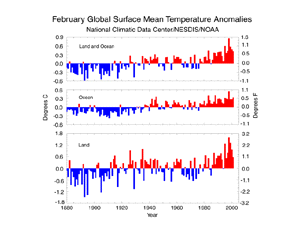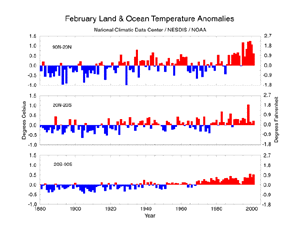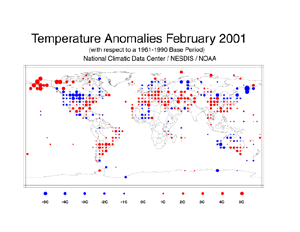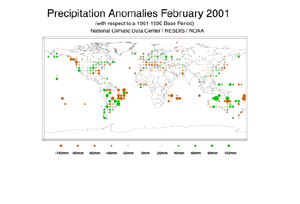 |

 Temperature
Temperature
| The land and ocean combined temperature averaged across the globe was 0.42C (0.76F) above the 1880-2000 long-term mean in February. Although the 7th warmest February since reliable records began in 1880, the monthly temperature was 0.44C (0.79F) less than the record anomaly measured during the 1998 El Nino episode. (The global temperature observed in February 1998 is the warmest monthly temperature anomaly recorded during any month.) Ocean surface temperatures were the 5th warmest on record [0.34C (0.61F) above average], while land surface temperatures fell for the third straight February as several land areas of the world experienced cooler than average conditions in February (see global map of anomalies below). The average land surface temperature was 0.58C (1.04F), approximately 1C (1.8F) cooler than in 1998. Temperatures in the lowest 8km of the troposphere were 0.04C (.07F) above normal, the 8th warmest February since satellite records began in 1979. Lower tropospheric temperatures in the Southern Hemisphere ranked as the 5th warmest (0.15C, 0.27F above average) while temperatures in the Northern Hemisphere were 0.07C (0.13F) cooler than average. Lower tropospheric temperature data is collected by NOAA's TIROS-N polar-orbiting satellites and adjusted for time-dependent biases by NASA and the Global Hydrology and Climate Center at the University of Alabama in Huntsville. |
| Temperatures in the tropics continue to be held down by the persistence of La Nina in the equatorial waters of the central Pacific. Averaged across the 20N-20S latitude band, land and ocean temperatures were 0.22C (0.40F) above average. Temperatures in the Northern Hemisphere extratropics (20N-90N) were notably cooler than the past three February's. Average temperatures were more than 1.2C (2.2F) above the long-term mean in 1998 and 1999 north of 20N, and temperatures remained near record levels in 2000. February 2001 was the tenth warmest February on record, 0.62C (1.12F) above average, while temperatures in the Southern Hemisphere extratropics were 0.52C (0.94F) above average, the 2nd warmest February in the 122 year series. |  |
 |
Above-average temperatures covered much of South America, with anomalies greater than 2C (3.6F) throughout a large part of Argentina. Temperatures were from 0.5C (0.9F) to 2.0C (3.6F) above average in the eastern half of Brazil. Southeastern sections of Australia also experienced above-average temperatures while western and northern sections of the continent were cooler than average. This temperature pattern across the Australian continent is consistent with conditions during much of the past year as the influence of La Nina brought generally wetter, and therefore cooler-than-normal conditions to northern and western parts of the country. |
| Widespread colder-than-normal temperatures coincided with negative 500-hPa height anomalies in northern and western areas of the United States. This region also experienced above-average snow cover during the month. Colder than normal conditions and severe winter conditions also occurred in northeast China and Mongolia. The most anomalously warm temperatures were recorded in Alaska and western Canada. Above normal temperatures were also prevalent in the eastern third of the United States and much of Canada. A large region of warmer- than-normal temperatures stretched from Western Europe to the Middle East and central China with some areas recording temperatures more than 3C (5.4F) above average. |

 Precipitation
Precipitation
| The most notable precipitation departures occurred in parts of South America and Australia in February. Extremely dry conditions covered eastern Brazil, with deficits exceeding 80 mm (3.15 in) in many areas. Above-normal precipitation occurred in some southern and western areas of the country as well as parts of Argentina. In Australia, extremely heavy rainfall fell in the Northern Territory in association with the remnants from five tropical cyclones (Terri, Winsome, Vincent, Wilva and Abigail) that affected the region during the month. Monthly totals more than 300 mm (11.8 in) above average fell in some parts of this sparsely populated region of the continent. Above-average precipitation also fell across parts of the central United States with much drier-than-normal conditions in eastern and northwestern parts of the country. Precipitation was also below-normal across a large part of southern Europe, the Sahel region in Africa, China and the Far East. |  |
For additional details on precipitation and temperatures in February see the Global Regional page .

References:
Peterson, T.C. and R.S. Vose, 1997: An Overview of the Global Historical Climatology Network Database. Bull. Amer. Meteorol. Soc., 78, 2837-2849.
 NOAA's National Centers for Environmental Information
NOAA's National Centers for Environmental Information